
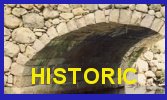
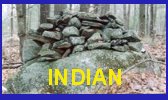
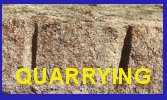
Robert Mullicken, Jr. (1688-1756)
Robert Mullicken, Jr. was the son of Robert Mullicken, Sr. He apprenticed with his father along with his brother, John. Circa 1726 Robert, Jr. and John took over the gravestone business. Robert, Jr. was a weaver like his father. His gravestones resemble his father’s but have different secondary designs that distinguish his work from both his father and brother. Robert, Jr.’s secondary designs are generally separated into two pieces and are tall under the face. Many of his stones have the work on an apprentice. Robert, Jr. appears to have been a patient teacher.
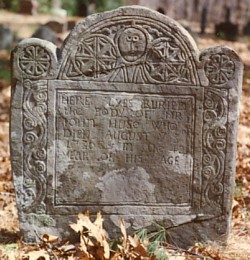 |
Standard design John Huse – 1736 – Newburyport, MA (formerly Newbury)
Mottled by lichens this is a good example of Robert, Jr.’s workmanship. He was conservative and neat in his carving. His designs are raised with straight sides. Secondary design under face is tall and separated into two pieces.
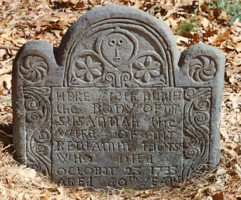 |
Crescent shaped whorls Susannah Morss – 1733 – Newburyport, MA (formerly Newbury)
Robert Jr. favored a whorl with crescent shaped blades. On this gravestone the whorls are opposite each other. Milestone 37 has the same type of whorls, crescent shaped and opposite. The whorl design on milestone 37 is attributed to Robert Mullicken, Jr.
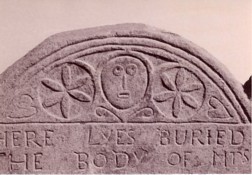 |
Apprentice’s work – Haverhill, MA
The close up shows the distinctive mask-like face and an apprentice’s carving. Hearts in side corners clearly show the work of someone learning to carve.
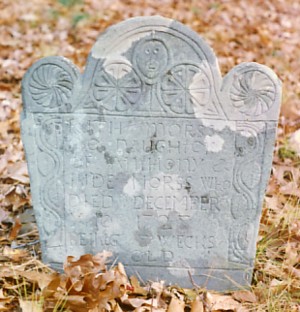 |
Child’s gravestone Ruth Morss – 1728 – Newburyport, MA (formerly Newbury)
For children Robert, Jr. carved smaller versions of adult gravestones. Here he made a gravestone for an infant daughter 8 weeks old.

